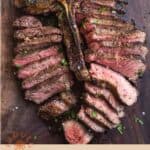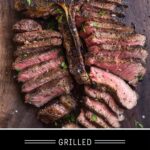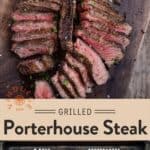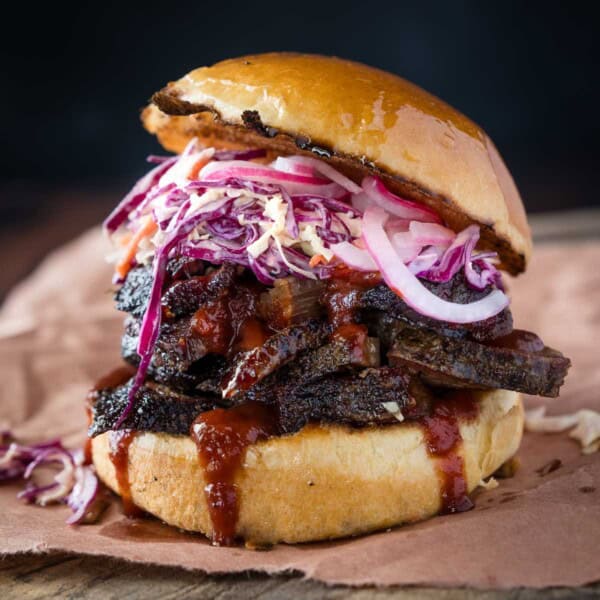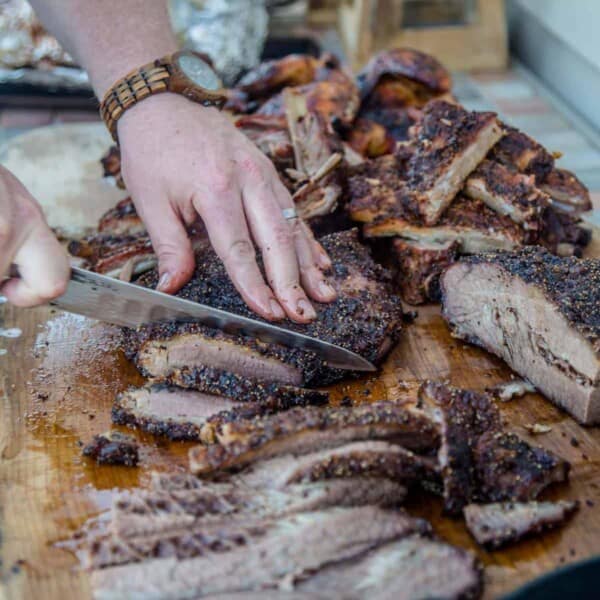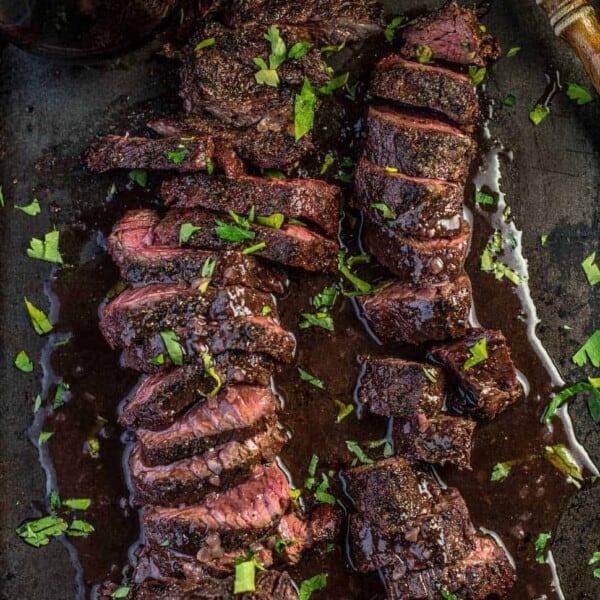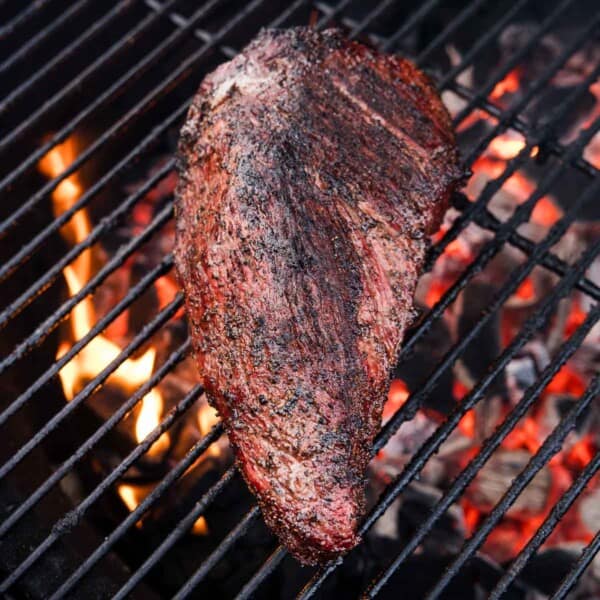This post may contain affiliate links. Read more at our disclosure policy.
A perfectly Grilled Porterhouse Steak is a piece of art! If you’ve purchased this massive cut of beef, you’ve come to the right place. Or maybe you have a T-Bone and you’re wondering what the difference is between a Porterhouse and a T-Bone? Short answer – not much.
With some simple seasoning and the right cooking method, you could be enjoying this masterful cut in no time!
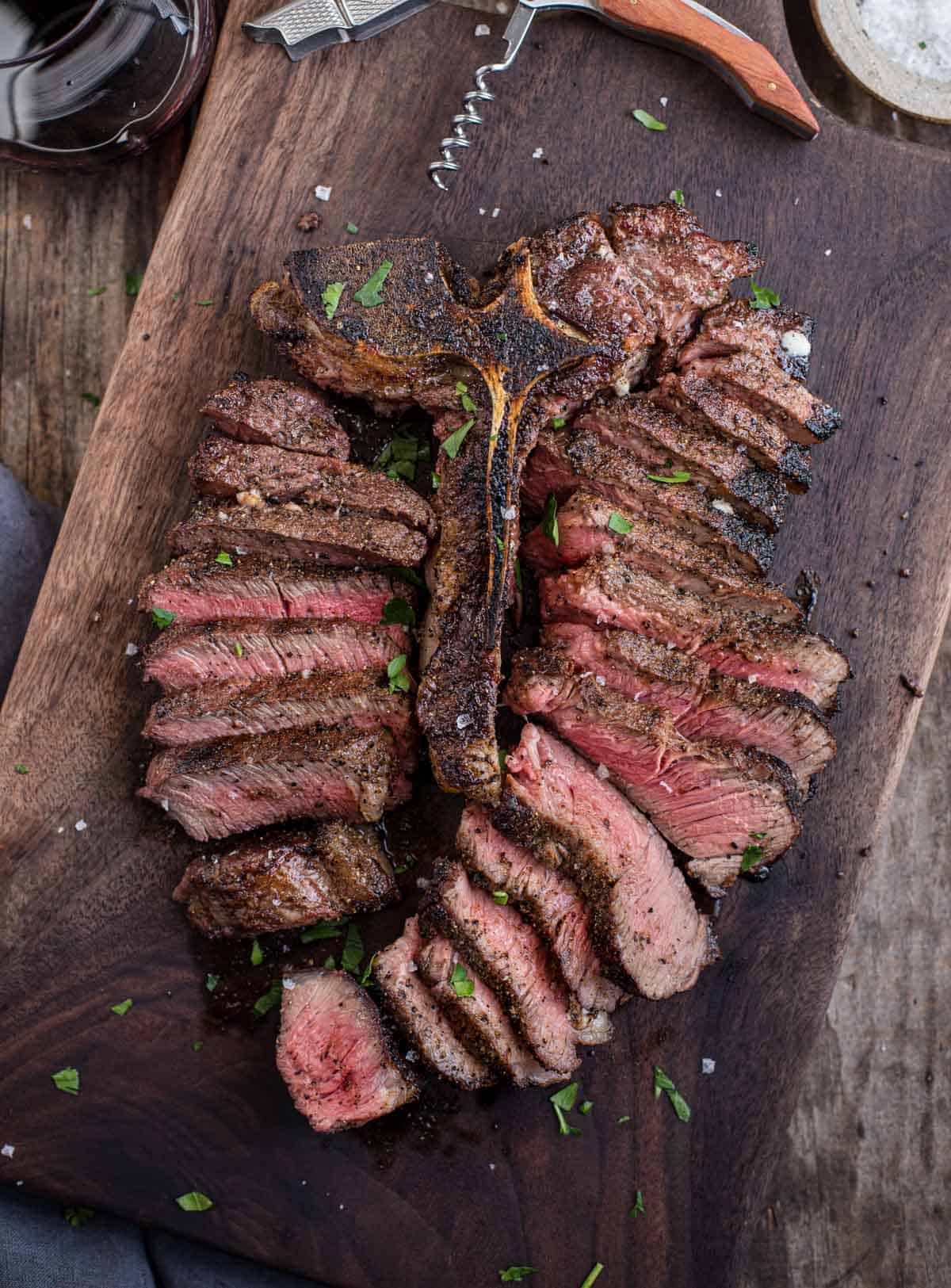
Steak cuts can be… well… diverse. There are so many to choose from, and it can often be hard to tell the difference between one or another, or which one you should buy. But one steak we want to make sure people know well is the Porterhouse Steak. We like to call it the big sister to the T-Bone.
Table of Contents
- What is Porterhouse Steak
- Porterhouse vs T-bone Steak
- Buying the Right Porterhouse
- Seasoning your Porterhouse Steak
- How to Grill Porterhouse Steak
- Ranges for Beef Levels of Doneness
- How to Cut a Porterhouse Steak
- Wine Pairing for Porterhouse
- Great Side Dishes for Porterhouse
- Reverse Seared Porterhouse Steak Recipe
What is Porterhouse Steak
The Porterhouse Steak (as well as the T-Bone) is a bone-in steak cut that contains two muscles — the tenderloin (where filet comes from, similar to this Grilled Beef Tenderloin recipe) and the NY Strip (or Strip loin). The two muscles are held together by a T-shaped bone that run along the spine of the cow. Because this muscle gets very little movement (versus a brisket), it is a very tender cut with incredible flavor.
The cut comes from the short loin of the cow where you will find your strip steaks and cuts from the beef tenderloin.
Porterhouse vs T-bone Steak
The main difference between the Porterhouse and T-Bone is the width of the tenderloin muscle. Porterhouse steaks need to have a minimum tenderloin width of 1.25 inches per the USDA Institutional Meat Purchase Specifications (IMPS cut 1173 – page 68 if you really want to geek out). Anything smaller technically is a T-Bone (if the width is greater than .5 inches). So Porterhouse Steaks are going to be bigger steaks in general. Since the Porterhouse contains two different muscles, they are generally very large (often around 2 lbs), and are a great cut to share with someone you deem worthy.
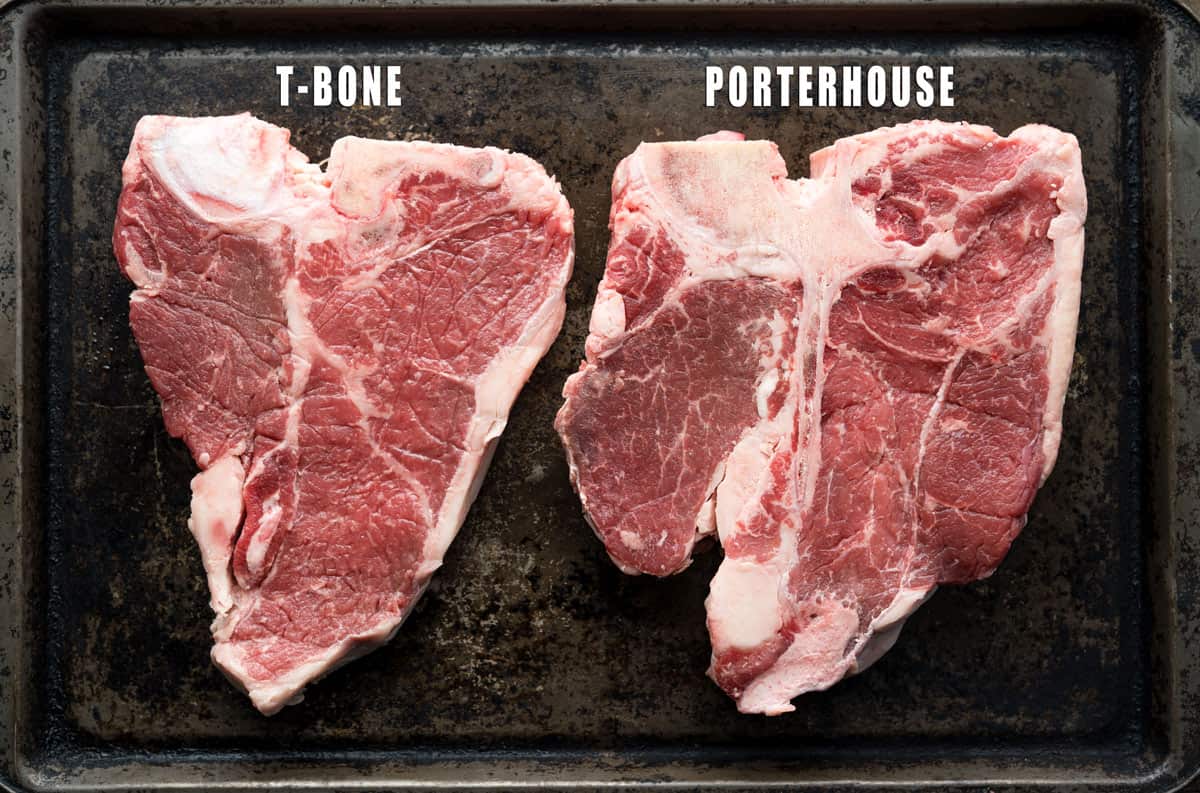
A good way to look at it is like this: all Porterhouses are T-bones, but not all T-bones are porterhouses.
Buying the Right Porterhouse
For grilling, or in our case reverse searing, you want a thick cut steak. At the minimum, buy 1 1/2 inches thick or more. A thin steak cooks quickly and you run the risk of overcooking it. A good butcher or local rancher knows this and will likely have them pre-cut into thicker cuts worthy of the grill. Otherwise call ahead and specify your steak thickness.
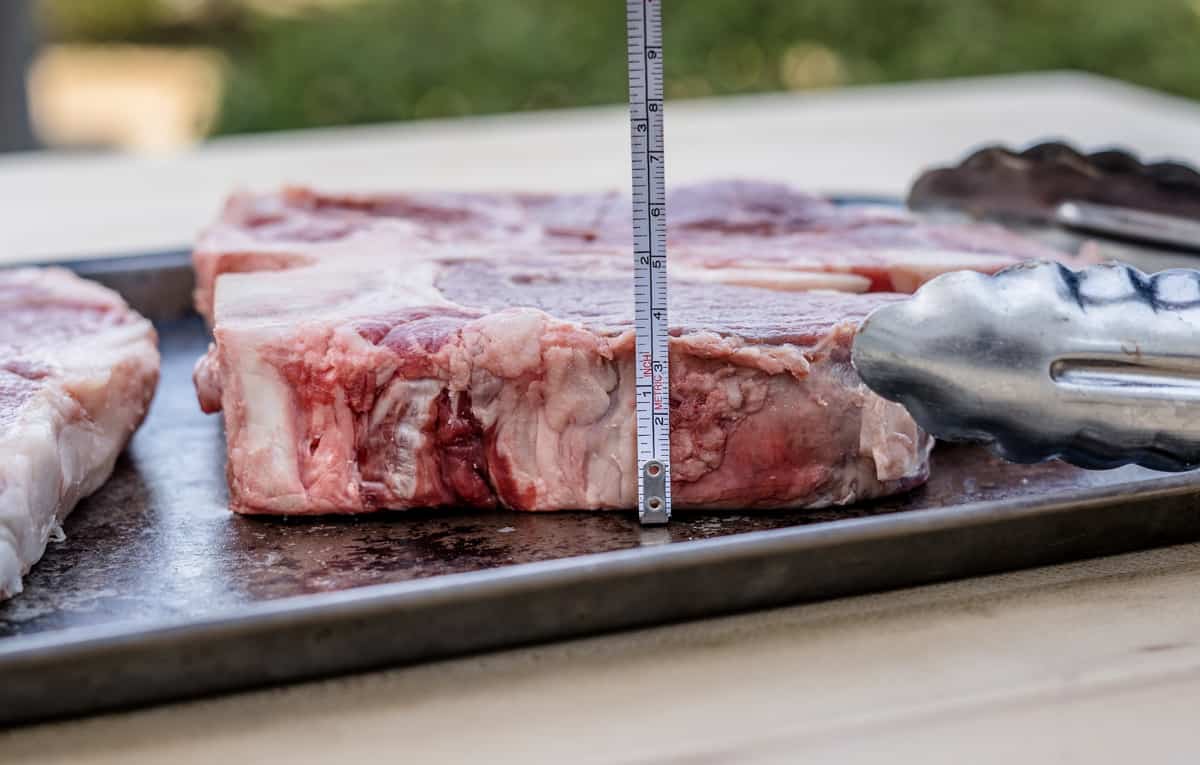
If you are curious about the rating system for meat, you can read more about our Choice vs. Prime summary. But in the end, opt for a steak with good marbling. Some ranchers may have prime level marbling, but just didn’t pay for the “stamp”. This will be especially present in the NY Strip portion of the Porterhouse steak.
Seasoning your Porterhouse Steak
Start with a light coating of extra virgin olive oil to the Porterhouse steak, then liberally apply the seasoning (dry rub). It’s then ready to go on the grill.
You can use any seasoning you like, but for good quality beef we encourage a simple seasoning in order to let the beefy flavor stand out. We use a beef seasoning that is comprised of kosher salt, coarse black pepper, and granulated garlic. Want to jazz up the flavor? Try our coffee seasoning.
If you want your Porterhouse steak to have more flavor, then add the seasoning at the end in the form of compound butter or relish on top of the steak. We have a great savory duck fat granola recipe in our cookbook Fire + Wine that is amazing on steaks.
Should my steak be at room temperature before I cook it? Simple answer – no. If the fire is hot enough, you can go from the refrigerator – to seasoning – to grill – and it will cook up perfectly (and you avoid any potential food-borne pathogens from a room temperature steak). And to be honest, even at one hour out of the fridge, the internal temperature will barely move the needle. So don’t waste the time.
How to Grill Porterhouse Steak
Because the Porterhouse steak is thick, the preferred method is to reverse sear, or grill and then finish over a hot fire or in a hot pan. It may sound time-consuming, but in less than an hour, you will have the most flavorful steak you have ever cooked.
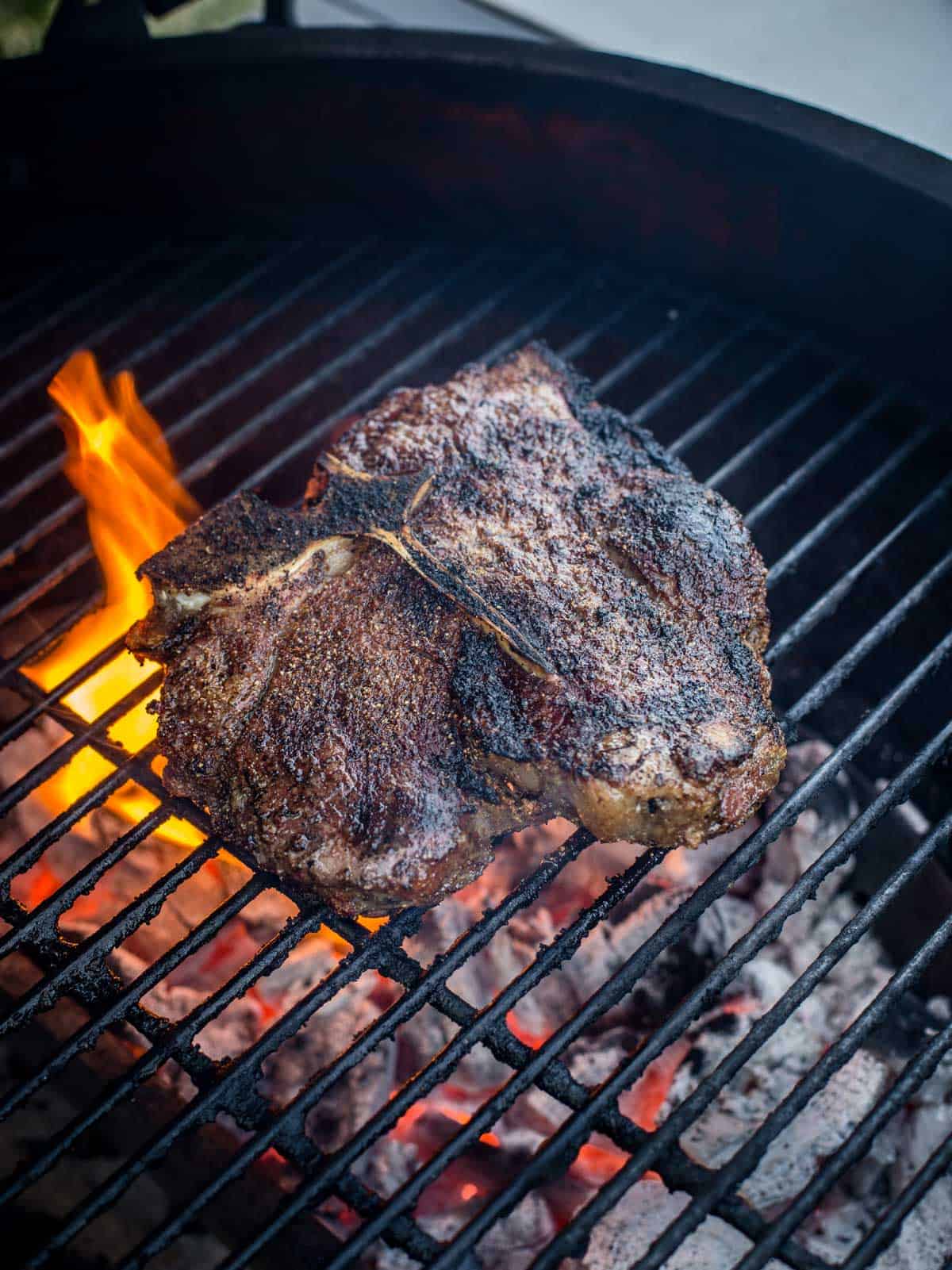
- Prep Grill: Preheat your grill to 250 degrees Fahrenheit (F) using a fruit wood like apple or cherry.
- Season Steak: Season the Porterhouse steak while the grill is coming to temperature.
- Grill at a Low Temp: Place the seasoned steak on the grill for 30 – 45 minutes or until the internal temperature of the Porterhouse reaches 110 degrees F in the thickest part. Use a good instant read thermometer, like the Thermoworks MK4 Thermapen, for the most accurate temperature reading. If you like your steak more on the medium rare side, grill until the internal temperature is around 120 degrees F.
- Increase Grill Temp (or prepare hot pan): Once the internal temperature of the steak is achieved, pull the steak off the grill and prepare it for direct grilling targeting 450 – 500 degrees F. Or you can transfer to a hot cast iron pan on the stove.
- Finish Steak over Hot Heat: Grill each side of the steak for 2 – 3 minutes until the internal temperature of the steak reads between 120 – 125 degrees F for rare, 130 – 135 degrees for medium-rare.
- Rest: Remove the Porterhouse steak from the grill and then let it rest for 10 minutes. This allows carry-over cooking to occur, where the internal temperature will continue to rise a few degrees and the cells in the meat will start to reabsorb the rendered fat and flavor, keeping the steak juicy. This is the time where you add your compound butter to the top of the steak to let it melt.
- Slice and serve.
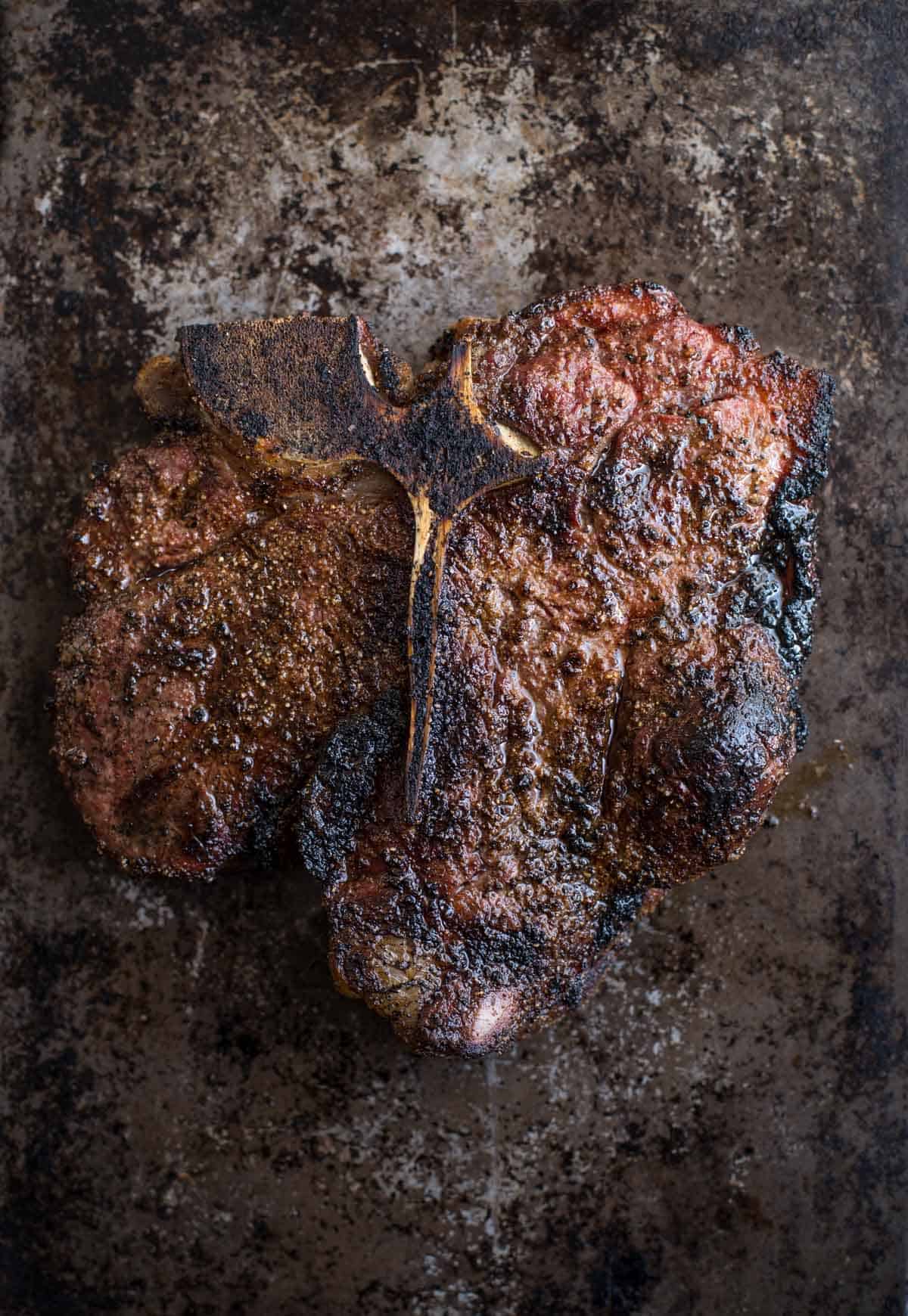
Would you like to save this?
Ranges for Beef Levels of Doneness
Beef Temperature Ranges
Be sure to take into consideration the carry-over cooking that happens while the steak rests. For steaks remove them 5 degrees lower than your desired temperature. For roasts remove them 10 degrees lower. The steak’s internal temperature will rise as it rests.
| Black and Blue | 100 – 120° Fahrenheit (F) | 37 – 48° Celsius (C) |
| Rare | 120 – 130° F | 48 – 54° C |
| Medium Rare | 130 – 140° F | 54 – 60° C |
| Medium | 140 – 150° F | 60 – 65° C |
| Medium Well (not recommended) | 150 – 160° F | 65 – 71° C |
| Well Done (not recommended) | 160 – 170° F | 71 – 76° C |
How to Cut a Porterhouse Steak
This may seem pedestrian, but cutting up a Porterhouse steak can be a pain the first time. This is primarily because the bone sits within the NY Strip and is not as easy to simply cut around. So we do the steak cutting for our guests before serving (remember we portion 1 steak for two people).
Start by separating the filet from the bone (whole) – a sharp boning knife is the best tool for this one. Cut your Porterhouse steak along the bone line. Next, remove the strip. Cut along the ‘T’ toward the base of the bone. The bone will not cleanly cut like the filet, so you will leave a little of the meat on and gently cut along the base where the bone ends.
Then cut up each steak into separate pencil width slices, then place back around the shape of the bone. It also makes for a beautiful presentation. Top with more compound butter if you would like.
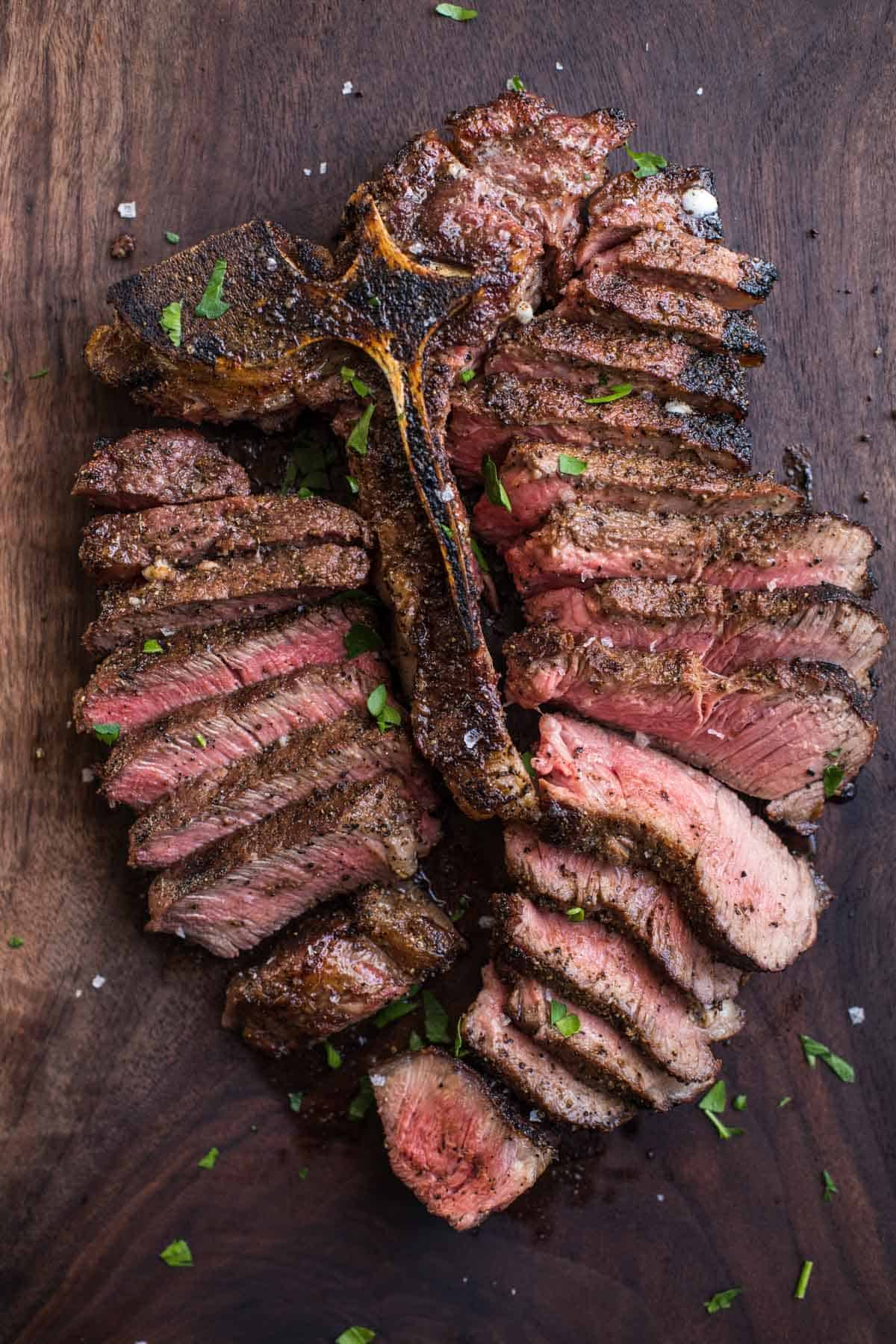
Wine Pairing for Porterhouse
When it comes to the well-marbled and tender, mildly smoky flavor, we turn to a bigger tannic red wine to pair with this colossal cut of meat. Cabernet Sauvignon is a standard and great go-to for this cut. A bolder style Merlot also works well. For an affordable option check out Malbec. Or this is also a good opportunity to open that Barolo or Sagrantino di Montefalco that you’ve been saving for the right occasion!
Great Side Dishes for Porterhouse
If you are looking for more great steak recipes, you can browse our favorite steak round up. And check out our grilled recipe if you ended up with a T-Bone Steak.
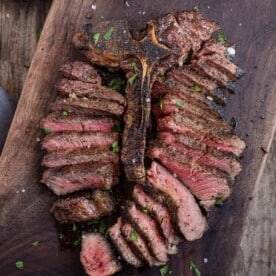
Reverse Seared Porterhouse Steak Recipe
Ingredients
- 1 24-ounce Porterhouse Steak, (try to buy at least 1 ½-inches thick)
- 2 tablespoons extra virgin olive oil
- 2 tablespoons beef rub , (1 tablespoon per pound of steak)
- 2 tablespoons compound butter , (to finish the steaks with)
Instructions
- Prepare Smoker – Preheat your smoker to 250 degrees Fahrenheit (F) using a fruit wood like apple or cherry.
- Season Steak – Coat the steak with olive oil, then coat all sides generously with the dry rub. Do this while the grill is coming to temperature.
- Smoke – Place the seasoned steak on the smoker and smoke for 30 – 45 minutes or until the internal temperature of the Porterhouse is at 110 degrees F in the thickest part. Use a good instant read thermometer like the Thermoworks MK4 Thermapen for the most accurate temperature reading. If you like your steak more on the medium rare side, smoke until the internal temperature is around 120 degrees F.
- Grill Hot and Fast to Finish – Once the internal temperature of the steak is achieved, pull the steak off the smoker and set it aside briefly, and prepare it for direct grilling targeting 450 – 500 degrees F. You can also transfer to a hot cast iron pan on the stove. Grill each side for 2 – 3 minutes until the internal temperature of the steak reads between 120 – 125 degrees F for rare, 130 – 135 degrees for medium rare.
- Rest then Serve – Remove from the grill and then let rest for 10 minutes. This allows carry over cooking to occur, where the internal temperature will continue to rise a few degrees and the cells in the meat will start to reabsorb the rendered fat and flavor keeping the steak juicy. This is the time where you add your compound butter to the top of the steak to melt
Video
Nutrition
Nutrition information is automatically calculated, so should only be used as an approximation.
